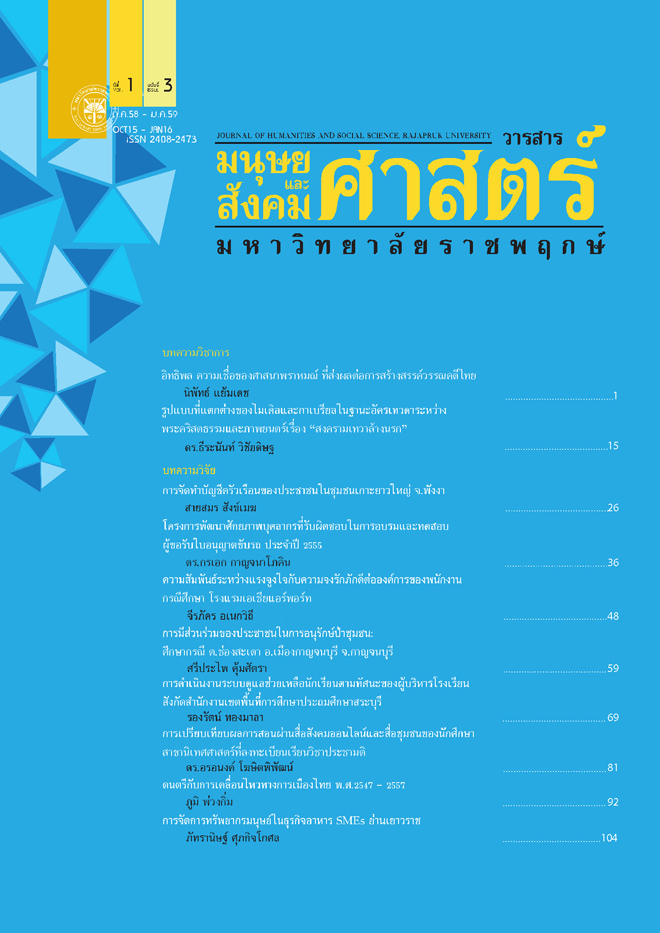A Comparison of Teaching through Social Media and Community Media Communication Arts students Enrolled Subjects Public Opinion
Main Article Content
Abstract
The purpose of this study were to 1) compare the achievement pretest. And after learning that public relation subject be taught through social media and community media. 2) compare the difference in achievement after learning that public relation subject be taught through social media and community media. 3) The study of student satisfaction with teaching through social media and community media. The research instruments were teaching materials in public relation subject coding 3033602, the achievement test and satisfaction questionnaire. The division among the students into two groups, one given to students through social media of 18 people the second given to classes by the media community of 14 people (on a voluntary basis of course). and the quality evaluation form. The data were analyzed by using percentage, mean and standard deviation. Compare with Paired t-test and Independent t-test.
The research findings were as follows: 1) The achievement test, there was a significant difference between the average of the students’ who have been taught through social media and community media. at statistically significance .05. 2) After learning achievement between groups of students who have been taught through social media and community media is no difference of statistical significance .05 3) The students in overall were satisfied be taught through social media and community media at high level.
Article Details
References
กาญจนา ดงสงคราม และคณะ. (2558). การบูรณาการจัดการเรียนการสอนสู่การบริการวิชาการชุมชนโดยใช้สถานการณ์ปัญหา. วารสารการประชุมวิชาการระดับชาติการจัดการเทคโนโลยีและนวัตกรรมครั้งที่ 1 มหาวิทยาลัยราชภัฏมหาสารคาม จังหวัดมหาสารคาม ในวันที่ 12-13 พฤษภาคม 2558.
ไพฑูรย์ ปลงสนิท. (2547). การศึกษาเปรียบเทียบผลสัมฤทธิ์ทางการเรียนด้วยบทเรียน e-Learing กับการเรียนในชั้นเรียนปกติ เรื่อง ทฤษฎีเบื้องต้นของออปแอมป์ วิชาวงจรอิเล็กทรอนิกส์ 2 ตามหลักสูตรประกาศนียบัตรวิชาชีพชั้นสูง สถาบันเทคโนโลยีราชมงคล ฉบับปรับปรุง พุทธศักราช 2543. สถาบันเทคโนโลยีพระจอมเกล้าพระนครเหนือ.
วรรณาพร จันทเรนทร์. (2550). ผลสัมฤทธิ์ทางการเรียนการสอนระหว่างบทเรียน E-Learning กับการเข้าฟังบรรยาย. มหาวิทยาลัยรามคาแหง. (ออนไลน์). ค้นเมื่อ 15 มกราคม 2558, จาก http://dcms.thailis.or.th/dcms
วิชัย นภาพงศ์. และคณะ. (2549). การพัฒนาบทเรียนผ่านเครือข่ายอินเตอร์เน็ต เรื่อง เทคโนโลยีทางกราฟิก (The Development of Web-based Instruction in Graphic Technology). ปีที่ 17 ฉบับที่ 1. (ออนไลน์). สืบค้นเมื่อวันที่ 13 มีนาคม 2558 จาก http://educms.pn.psu.ac.th/edujn/viewarticle.php?id=62
สุขญา สังข์จรูญ. (2550). ผลของการเรียนบทเรียนบทเว็บโดยใช้บล็อกที่มีต่อผลสัมฤทธิ์ทางการเรียนและความคงทนในการเรียนวิชาภาษาอังกฤษของนักเรียนชั้นมัธยมศึกษาตอนต้น วิทยานิพนธ์ครุศาสตรบัณฑิต สาขาโสตทัศนศึกษา. จุฬาลงกรณ์มหาวิทยาลัย
อุบลวรรณ หงษวิทยากร และ ณัฐวดี ใจแสวงทรัพย์. (2557). การสร้างเสริมทุนชุมชนผ่านการเรียนรู้จากการสร้างสื่อศิลปวัฒนธรรมท้องถิ่น. วารสารอิเล็กทรอนิกส์ ทางการศึกษา. สาขาวิชาพัฒนศึกษา ภาควิชาภาควิชานโยบาย การจัดการและความเป็นผู้นาทางการศึกษา คณะครุศาสตร์ จุฬาลงกรณ์มหาวิทยาลัย. ปีที่ 9 ฉบับที่ 2 /2557. (ออนไลน์). ค้นเมื่อ 13 มีนาคม 2558, จาก http://www.edu.chula.ac.th/ojed/home.asp
โอกาส เกาไศยาภรณ์. (2548). การพัฒนาบทเรียนการแสวงรู้บนเว็บเรื่องการจัดพิพิธภัณฑ์ในสถานศึกษา. กรุงเทพฯ: ซีเอ็ดยูเคชั่น.
Safran, C. (2010). Social Media in Education. Thesis for the Award of the Academic Degree of a Doctor of Technology, Graz University of Technology.
National School Boards Association. (2553). สถิติเกี่ยวกับ Education 2.0 ในสหรัฐอเมริกา. ค้นเมื่อ 8 มกราคม 2558. จาก: http://www.columnfivemedia.com/socialcast-infographic-education-2-0/


